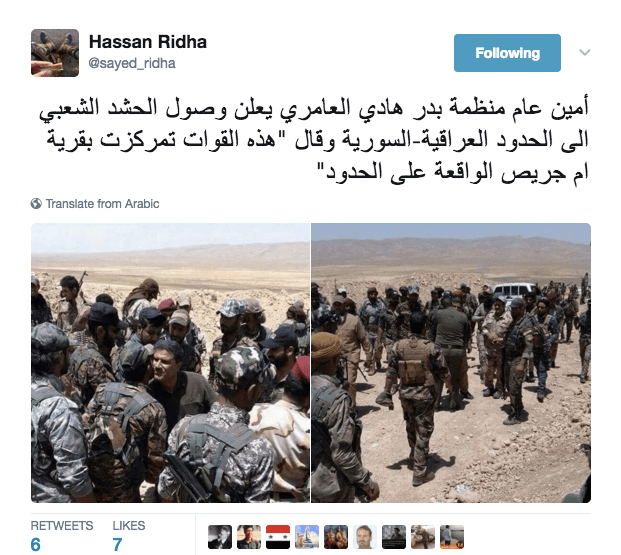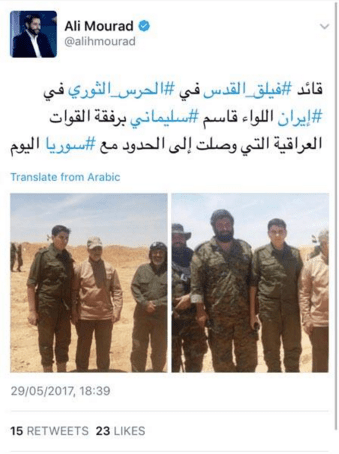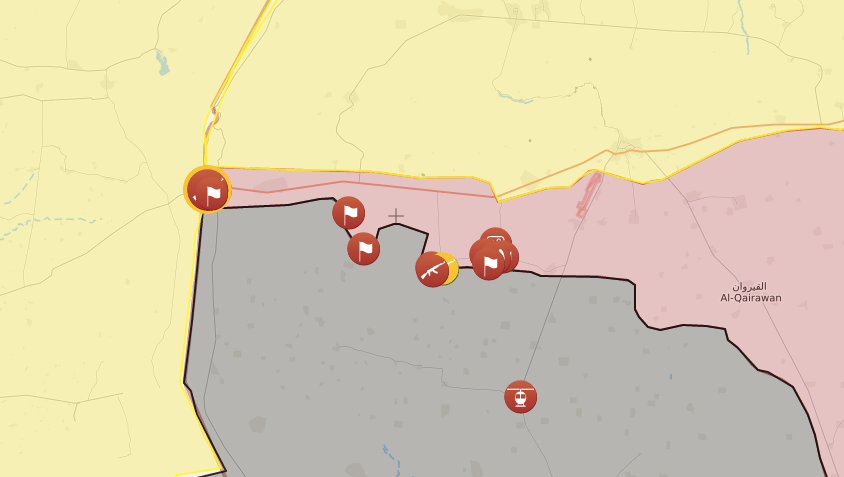By SETH J. FRANTZMAN
Just after noon on May 29th the Hashd al-Shaabi, or Popular Mobilization Units (PMU), a mostly Shia group of militias that have been officially part of the Iraqi government since late 2016, claimed to have reached the Iraq-Syrian border near Sinjar. This is a strategic corridor. It is one that ISIS used in 2014 and one that jihadists have used in the past to cross from Syria to Iraq. The fact that the Shia militias crossed 40km of open desert in several days to get there is a strategic game changer in the war on ISIS and for the region.

One of the tweets about the PMU reaching the border. (screenshot)
Hadi al-Amiri, the Badr Organization and Badr brigade commander went to the border at Um Jaris according to photos and tweets and said that the PMU would clear the border area heading south towards Al-Qaim and Al-Bukamal. According to another tweet the Iranian IRGC commander Qassem Soleimani also went to the border area.

Qasem Soleimani at the border (screenshot)
The appearance of Soleimani, who is in several different photographs, is important because it shows direct Iranian influence and involvement, besides the well known fact that Badr and other PMU militias are close to Iran, their senior officers served with Iran in the 1980s and they fly sectarian Shia flags and have poster showing Iranian supreme leader Khamenei.
The arrival of the PMU cuts off ISIS and drives a wedge between Kurdish forces in Sinjar, including Peshmerga and the PKK and YBS (Sinjar resistance units) and ISIS. It means the main border of the Kurdish region from Sinjar to Tal Afar is with the PMU.
The implications are not lost on Turkish commentators such as Ragip Soylu, who notes “Iraqi Shiite militia reaches Syrian border. Now Iran has two access points to Syria, first through PKK-held Sinjar, now with PMU.”

Allegations that PKK and Hashd meeting (screenshot)
Importance of PMU’s recent actions around Mosul
I’ve written on the PMU’s latest offensive that began in mid-May and which was initially focused on Qairawan and Ba’aj. After it took several Yazidi villages near Sinjar, such as Kocho, the scene of many ISIS crimes and genocide, it found easy going all the way to the border, bypassing ISIS resistance. I have also written about claims that Iran is trying to forge a “Shia crescent” via northern Iraq. The Shia militias, outside the immediate center of the Mosul offensive, are the primary power in northern Iraq. They run the checkpoints and have done the heavy lifting around Tal Afar. I saw them first hand and have written about them.

Shia militia poster with Khamenei on it near Hamam al-Alil (Seth J. Frantzman)
Background: Iran’s “road to the sea”
The idea that Iran is searching for a road to the sea has been floating around for some time. It was articulated last year in a piece by Martin Chulov at The Guardian. He claimed “A senior intelligence official said the leg between Tel Afar and Sinjar is essential to the plan….he PKK fighters are being paid by the Iraqi government and have been incorporated into the popular mobilisation units. Iraqi and western intelligence officials say the move was approved by Iraq’s national security adviser, Falah Fayadh.” However changes in the politics of Sinjar frustrated the idea that it would be part of this “road” and Chulov updated his piece in May 2017 with a new “route” to the sea. “The new corridor has been moved 140 miles south to avoid a buildup of US forces that has been assembled….The pivot to the west, bypassing Sinjar, has now pitched Iranian-backed forces into direct combat with Isis, serving the twofold goal of taking an increased role in the war and laying a cornerstone along the new course.”
Fabrice Balanche at the Washington Institute for Near East Policy has also written about potential Iranian routes to the Mediterranean. Sinjar figured here as well. “To be sure, the feasibility of opening this route is not yet assured because the Islamic State is still present south of Sinjar, while the KDP and PKK are currently clashing for control over Sinjar itself.” In May he also added to this to look at how it might impact Syria.
Jonathan Spyer notes in a recent piece at The Jerusalem Post that “The Iranians and their allies want to penetrate Islamic State territory from west to east, with the Iraqi Shi’a militias pushing westward from Tel Afar and Assad regime forces and pro-Assad militias (including Hezbollah) probing east.”
Mark Langfan also penned a piece looking at the Iranian route at Arutz 7. “Does the Islamic State want the Iranian Shiites to win the At-Tanf/Abu Kamal/Ar Rusafah Triangle, to win Syria, and become the unstoppable Shiite hegemon?”
***update***
Hezbollah member Mahmud Shri allegedly was killed during the operation, linking Hezbollah closely with PMU.
Implications?
The recent changes on the ground, in a kind of deadly chessboard, is moving the balance of power in the conflicts in Syria and Iraq. Since ISIS invaded Iraq in 2014, the conflict has been largely one large war. The PMU’s rise to power comes directly in response to ISIS. The US has been upping its role in Syria with increasingly more support for the SDF since the start of 2017. This has caused tensions with Turkey. In April Turkey bombed Sinjar which it has vowed must not become another Qandil-style base for the PKK.
For Turkey
Turkey has been outraged about the presence of the PKK in Sinjar. The arrival of the Shia PMU only increases its concerns. It is also concerned about the battle for Tal Afar, a Turkmen town. And it is keeping a keen eye on Mosul, where it has historic interests. From Turkey’s view all that has happened is its allies are being weakened. It didn’t get to help Syrian rebels take Raqqa. It has lost out in Mosul. It has lost out in Sinjar. The question is where is its red line. The PMU dash to the border doesn’t seem to be a red line, but it is still making noises about Sinjar and allegations of PMU atrocities will fuel Turkish demands for intervention in Tal Afar. Turkey has good relations with the KDP and the Kurdistan Regional Government in Erbil. It has major trade with the region. In this sense it uses its influence in norther Kurdistan. It has common concerns with the Peshmerga, both regarding the PKK in Sinjar and the rise of the PMU.
For the KRG, Kurdish autonomous region
Erbil is concerned about what will happen now that the PMU borders Sinjar. Before the war the Peshmerga were in Sinjar, but ISIS overran them in August 2014. This left bitter accusations that they had fled. It resulted in the YPG and PKK helping to save Yazidis and carving out a presence. This led to the creation of the Yazidi YBS. However there have been clashes this year between the PKK aligned YBS and the KDP aligned Rojava peshmerga and Sinjar has been a low simmering conflict. This prevents hundreds of thousands of Yazidis from returning. Now the PMU adds to this mix. Liberating sites of Yazidi genocide in Kocho, it has recruited some Yazidis.
The rapid PMU advance has worried the Peshmerga and Erbil. This worries Erbil’s view of post-ISIS Iraq and the “disputed territories” such as Sinjar. Rudaw notes:
“Under the Iraqi constitution’s Article 140 the status of Shingal – and other areas, most notably Kirkuk – is supposed to be resolved through referendum of these regions’ inhabitants. This raises the prospect that after ISIS’s removal, the Hashd could continue to maintain a presence, establish facts on the ground and challenge the Kurdistan Regional Government’s (KRG) authority there in disregard of whether or not Article 140 is ever implemented, as most of the local population is expected to vote for full integration into the Kurdistan Region.”
It isn’t clear what Erbil can do except keep protesting to Baghdad. The question is whether tensions can cool in Sinjar because the Peshmerga forces there are outnumbered by the PMU. If the PMU moves south then the question is whether the Kurds can encourage Yazidis to return to rebuild Sinjar town itself.
The arrival of the PMU will increase tensions with the YBS and PKK in Sinjar, and Erbil will watch closely to see if the fears about a “link up” of the PMU and PKK come to fruition.
*** Update***
Nadia Murad visited Kocho on June 1st and also was seen briefly with Abu Mahdi al-Muhandis.
For Iran
Iran has never been happier with its influence and power in Iraq than it is now. It dominates not only Baghdad but parts of northern Iraq. It wants to expand that influence to link up with its friends in Beirut and Damascus. The question is whether it will reach over-stretch or risk provoking a response, such as the American air raid against Syria regime forces near Tanf. The US has a close alliance with the SDF and works with the Iraqi army to fight ISIS along with the partner nations of the CJTF:OIR, but is unwilling to associate with the PMU. If Iran overplays its hand it risks tensions and conflict with the US. The Trump administration will not work with Iran the way Obama appeared more willing to do.
Iran’s next move and its influence over the PMU is a key question. Not all the militias are close to Iran and there are other issues in Baghdad relating to internal Iraqi politics, such as leaders like Muqtada al-Sadr (who recently formed a new militia).
For the US
US policy has been janus-faced on Iraq in recent years. It has worked closely with Baghdad and Erbil, but it knows the Iranian-backed PMU loathe the US. Defense department officials recall that these kind of militias once attacked Americans. The US wants to defeat ISIS and is leading a 68 nation coalition to do so. But does it want to pave the way for Iranian hegemony? It doesn’t so it has to make sure the SDF is wary of the Syrian regime, wary of the PMU and to continue to support Jordan and the training of Syrian rebels near Jordan. This can ward off the PMU.
In addition Trump’s recent Riyadh trip means that both KIng Abdullah in Jordan and the Saudis are listening to the Americans and sharing concerns about what is happening in Iraq. Although Saudi has renewed some relations with Baghdad, it vehemently opposes the PMU and Assad. What can it do against them though?
For Syria
For the Syrian regime the arrival of the PMU on the border adds more allies in the war against the rebellion. But the immediate help cannot come. Shia militias have expressed interest in fighting in Syria, but their immediate goal is to roll up ISIS along the border. For the Syrian rebels the arrival of the PMU has no real implications until they get closer to al-Qaim and the areas where the rebels are in Syria. For the SDF the new border with the PMU is unclear. The YPG and SDF have terrible relations with Erbil, but so far do not seem to have any real relations with the PMU or Baghdad. With a new border that may change.
***update*** Abdulla Hawez reports that PYD Asayish security held a meeting in Qamishli to discuss the development and implied they want to “counter” it if it means the Assad regime will seek to link up with the PMU.
***update 2***

Screenshot on May 29 from the ISIS live map
For Iraq
The new corridor is a major strategic development. It changes the map of the conflict in Iraq for the first time since the war began in 2014. For the first time the Iraqi government is now back at the Iraq-Syria border. It is now in the form of Shia militias which shows how important they are in the war effort. The question is now whether they are the major force in the country, more important than the army, more important than the Federal Police and the ISOF (counter-terror forces). If the militias have become the major force in Iraq, and they dominate the rest of the war on ISIS, they will run much of post-ISIS Iraq. Their checkpoints with sectarian flags will dominate the north, and that will likely lead to a new cycle of violence with Jihadists. But for now they are riding a wave of power, unprecedented in history.
The power of the PMU has implications for the Kurdish region which is seeking a referendum on independence. If the PMU, or Iran, wants to influence the Kurdish region it can now create pressure along the PMU-Peshmerga border. There have been clashes in the past in Tuz Khurmato and there will likely be again.
Iraq wants to finish the battle in Mosul, where Abadi arrived on Monday and met with PMU leader Abu Mahdi al-Muhandis. Once Mosul is over attention turns to Tal Afar, Hawija, Anbar and other areas. Clearly Abadi gave the go-ahead, or was presented with a fait accompli, for the PMU operation to cross to the border. If he has been outmaneuvered or taken by surprise he hasn’t said anything. So after Mosul, what will he order the Iraqi army to do. The Iraqi army has been upping operations in Anbar in the last month, perhaps aiming to create a pincer along the border with the PMU.
For Sunni Arabs in Iraq, the success of the PMU leaves them weaker and more divided than ever.
*** update*** There are claims the YBS still controls the border crossing. Matthew Barber reports that some Yazidis left the Peshmerga and joined the PMU during the operation. However there are tensions between YBS and the PMU over access to Yazidi villages. Even though there were cordial photos taken the Hashd objected to them entering the village of Siba due to the presence of women fighters. Barber tweeted: “In a meeting attended by YBŞ fighters, Hashd commanders said ‘It is forbidden by the shari’a for women to fight in the ranks of military.'”
For Russia
Russia has warned that removing Assad would turn Syria into something like Iraq, although it isn’t clear what that means. Most of Syria is as bloody and unstable as Iraq. Russia supports the “de-escalation” zones in Syria as it strengthens Assad’s hand. It condemned the US airstrikes near Tanf. But its Iraq policy is not clear. In 2015 Erbil airport had to be closed due to Russian missile strikes in Syria. Russia has supported Iraqi Prime Minister Abadi but it knows Iraq is under the US sphere of influence. It likely welcomes the PMU on the border and will wait and see where the PMU heads. Russia has amicable relations with the YPG, which makes it a partner with the US in Syria, a potential positive. Russia has also stressed the Hezbollah should leave Syria when the conflict is over, and Russia is closer to Damascus than it is to Tehran.
For Israel
Israel’s main interest is in not having an Iranian-backed militia “corridor” from Baghdad via northern Iraq to Syria and Hezbollah. Israel has tacit relations with the Syrian rebels, and it works on “de-confliction” with Russia. Israel has taken credit for an air raid deep into Syria near Palmyra this year and is said to be behind numerous strikes to prevent Hezbollah from obtaining weapons via Syria. A land corridor only adds to headaches in Jerusalem. But the corridor is far from complete and there is much to do. The appearance of Iranian IRGC with the PMU threatens Israel, but the proximate concern is Hezbollah.
***update***
Hezbollah member killed in PMU operation;
